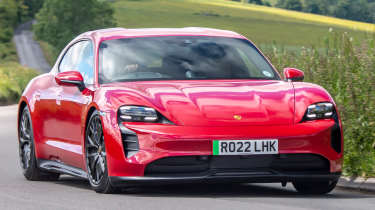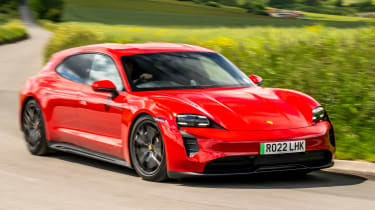Porsche Taycan GTS Sport Turismo 2023 review
The Taycan GTS is superb in both saloon and Sport Turismo forms – it's the driver's choice for EVs right now
Most of us have come to know what Porsche’s GTS lineage stands for: a focus on vehicle dynamics while deferring in terms of sheer horsepower to the most powerful in the range; a unique look, but nothing as drastic as changes to the overall body-in-white, and a wealth of standard equipment, either for a keen price or perhaps in a combination that can’t otherwise be ordered. At its best, it’s given us some of the very finest Porsches, such as the 997.2 Carrera GTS. For the Taycan GTS, the expectation is clear – this should be the electric car for drivers.
The £110,200 GTS sits between the 4S and the Turbo in both price and power – with 590bhp it holds a 27bhp advantage over the 4S, and gives up 81bhp to the Turbo. But this is only part of the story, because the GTS uses the full-house electric motor on the rear axle, and a weaker one at the front. What this means, in crude terms, is that it’s effectively much more rear-driven than the Turbo and Turbo S models, which has an impact on the car’s handling characteristics.
Porsche engineers refer to the Turbo S as the power monster for the autobahn, but when it comes to driving, the GTS is the one they’re excited about. It also boasts the best range of the Taycan lineup at 313 miles from a full charge, but it’s worth noting that this has been achieved through a new version of the car’s software, which is being rolled out across all Taycan models. However, given those other models haven’t been homologated with the new software, Porsche can’t claim the revised figures for them (some of which would be higher still), so the GTS wears that particular crown for now.
More reviews
In-depth reviews
Review
Reviews
The GTS has 20 percent stiffer anti-roll bars front and rear, and higher spring rates, while the three-chamber air suspension set-up now uses all three chambers only for Normal mode, with Sport and Sport Plus both reverting to a single chamber, unlike the 4S. The optional PDCC active anti-roll bars and rear-wheel steering have also been configured to suit, and the car we drove had both those options fitted, while the steering takes on a different feel given the changes to the suspension. There are new 21-inch GTS rims too, some 5kg a set lighter than the existing 21-inch Mission E rim, while if you do order those 21s you get a sportier tyre over the more range-biased rubber fitted to the 20-inch wheels the car comes with as standard.
Spotting a GTS is fairly easy too, given the amount of black trim and the Sport Design body kit they will all come with. Inside it’s awash with Porsche’s Race-tex upholstery (akin to Alcantara) and there’s also the option of a new panoramic roof that can switch from clear to opaque at the press of a button.
For an extra grand, you can opt for the more versatile and arguably even more attractive Sport Turismo estate, as tested here. The Taycan casts a pretty large footprint at just under five metres long and almost two metres wide, but as ever, packing a large battery within that slender shape is a challenge. Even in Sport Turismo form, the rear seats are tighter than they ought to be in a car as long as a 5-series.
But this is a GTS, so the business happens up front. It’s a fantastic driving environment, even if the heavily digitised design is a little unimaginative. The small, suede-trimmed wheel extends right out to meet you, the seat drops low and there’s a genuine sense of purpose that doesn’t square with a 2310kg EV. Oh yes, this most racy of Taycans weighs nearly half a ton more than an M5 CS.
Even so, the acceleration is still of the absurd, gut-squeezing variety that’s now familiar with fast EVs. The GTS may ‘only’ offer up to 590bhp, but that’s enough for 0-62mph in just 3.7 seconds – the huge slug of instant torque is enough to launch the car in eye-popping fashion, make no mistake. There’s also a louder and unique ‘artificial engine noise’ in the cabin, which can at times sound a little like a V10 at low revs, as in the subtle resonant tones of the old C6-gen Audi S6. It has a more obvious change in pitch than the usual Taycan’s starship whir, which gives the impression of different gears being used. This might read like we’re desperately searching for an element of soul to the GTS, and you might be right, but it’s amazing what a bit more noise can do to the driving experience, even if the effect is wholly subconscious – and artificial.
Like any Taycan, the GTS is an effortless long-distance car (public charging and range limitations aside). Switch the suspension to Comfort mode and it cruises serenely for the most part, swallowing uneven tarmac while minimising the vertical float that’s so typical of heavy, air-sprung cars. The illusion breaks over certain high-frequency bumps though, and the GTS can suddenly feel disjointed as impacts tremor through the chassis.
This can’t be escaped in any of the three modes, with Sport and Sport Plus feeling more reactive over bumps that the GTS can otherwise take within its suspension travel. For an EV the Taycan is well resolved, but lighter, ICE-powered saloons and estates on conventional springs have greater breadth and consistency. The same is true of the brakes – the low-speed calibration could be slicker and the pedal lacks the reassuring bite and modulation found in Porsche’s conventional performance cars.
If you find a decently surfaced road and dig deep within the Taycan’s abilities, it’s much harder to pick holes. The steering is superb. Details permeate through the thin rim and the rate of response is beautifully judged – and perhaps a hair quicker than you expect – giving the impression of huge potential even before you’ve got to the meat of a corner. Once turned in the Taycan takes set, and it’s here where you feel the electronics massaging more performance from the car, in particular the rear-wheel steering. In long curves it’s subtly introduced when the front tyres threaten to slide, keeping the car nailed on your chosen path in what feels like sorcery.
It’s only really through hard, deliberate inputs – those that you’ll hardly be making on the road, it must be said – that the Taycan’s mass feels overbearing. Hustle it through a direction change or barrel into a corner too quickly and yes, the weight reveals itself. But the GTS can still live with an uncanny level of commitment for such a heavy car, tucking into apexes on a trailing brake and firing out the other side in a blink, sometimes with a quarter turn of opposite lock. The thrust when you get on the throttle doesn’t feel disproportionate to the cornering potential of the GTS either, which goes some way in making it feel like a cohesive driver’s car.
The dynamic nuance and sheer ability that Porsche has conjured with the GTS is a huge achievement. This is a superb driving machine, EV or otherwise, and one that leaves us highly intrigued at the prospect of a more conventional (and hopefully much, much lighter) sports car when the electric 718 arrives. If the same tricks are applied there, it could crack the electric performance car enigma.
Prices and rivals
Priced at £110,200, the GTS sits – you guessed it – halfway between the family models on either side of it. It’s very much the driver’s choice in the Taycan range, though, whatever the price. The closely related Audi RS e-tron GT is a few thousand more expensive, but as we found over our six-month tenure with one of those, its dynamics are far from perfect.
The Mercedes-AMG EQS 53 is far bigger and more powerful, so too is Tesla’s Model S Plaid and the new Lucid Air, but for now it’s the Porsche and Audi that have a monopoly on the large performance EV saloon genre and of the two, we know which we’d go for.








